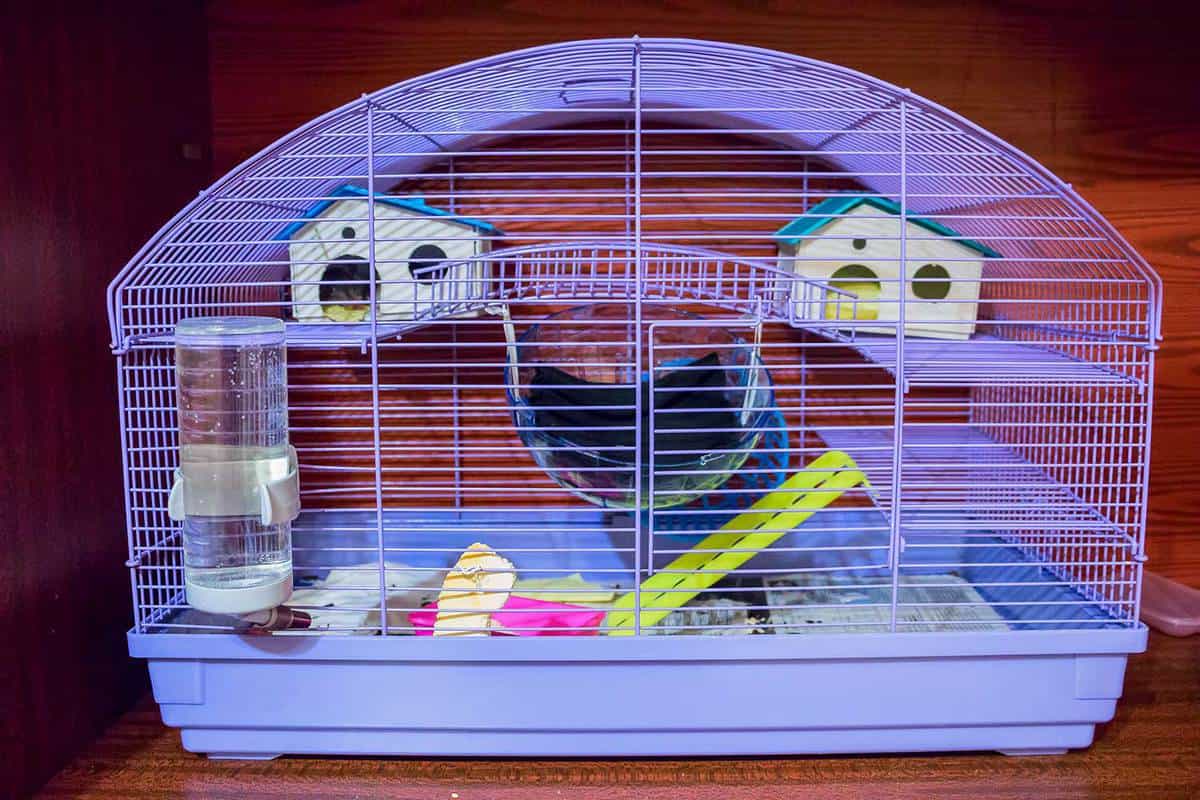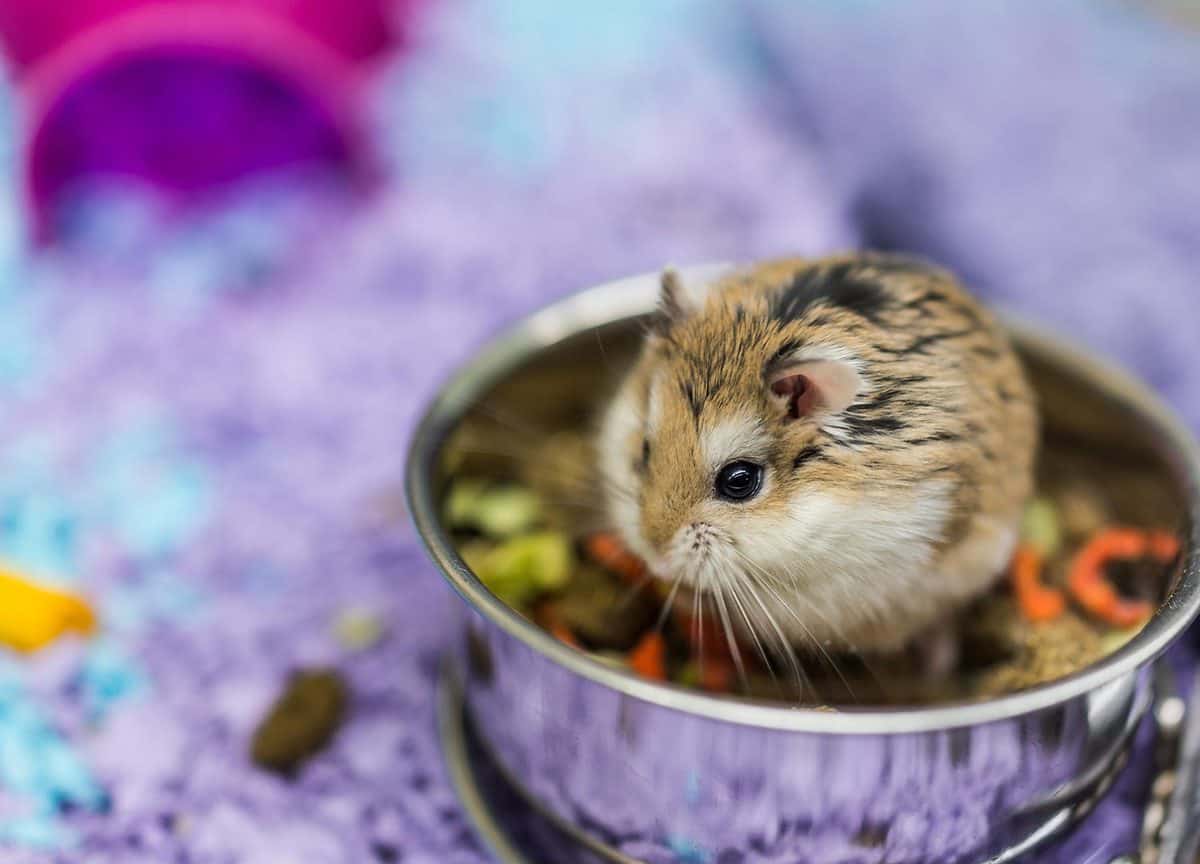 There are a lot of factors that go into deciding on a cage for your hamster, but the most important one is the cage’s size.
There are a lot of factors that go into deciding on a cage for your hamster, but the most important one is the cage’s size.
With this in mind, you’ve probably thought to yourself, what would be the right size cage for me to buy?
Experienced hamster owners suggest 450 square inches as the minimal size for a hamster's cage.
Bigger IS better when it comes to your hamster's cage, so try to get a larger cage if possible and follow up with getting the best possible setup inside, to provide your little furry friend with a rich and interesting environment.
However, there are still other factors to consider when choosing a hamster cage size: type of hamster, ease of cleaning, and ventilation.
And if you keep reading, We’ll elaborate further on these factors to ensure you pick the perfect cage for your hamster.
What's the recommended cage size for a hamster?
Imagine if you were to spend most of your day caged. Naturally, you'd want that space to be -
- As large as possible.
- Filled with fun things to do!
It's the same with your hamster, really. We tried researching for actual guidelines - and it wasn't easy! Organizations such as the Animal Humane Society, and the British RSPCA no longer state any concrete numbers when it comes to hamster cage size.
Instead, they opt for a general "as large as you can" recommendation. The ASPCA recommends getting as large a cage as you can and mention a 10 gallon as the minimal size.
In the past, the American Humane Society used to recommend 288 square inches as the minimal size for a hamster size, and we used to reflect that here in this post. Follow-up comments by page readers encouraged us to take down that recommendation (thank you, guys!
We appreciate the feedback and want to help hammies out there get better care!).
So, if you want to keep your hamster healthy, happy and as stress-free as possible, we recommend sticking with the standard put forward by Hamster Hideout: 450 square inches.
Look for large enough tanks or cages to give your little pet the perfect home.
Syrian Hamsters Cages vs. Dwarf Hamsters
Surprisingly, there is not a huge difference in the needs of these two species when it comes to living space.
Dwarf hamsters may be smaller but they still need a large enough territory to call their own.
Examples of large hamster cages
Here are some great cages you can order right off Amazon.
Prevue Pet Products 528 Small Pets Cage
This cage is 32.5 long and 19 inches wide, providing a total of over 600 square inches of floor space divided between two levels.
The second floor isn't too high, making it safe enough even for a clumsy hamster.
Wire spacing is under half an inch, which is safe for an adult Syrian hamster.
See full details and order on Amazon
Niteangel Glass Tank for hamsters
If you're looking for a tank kind of cage, this one comes highly praised by hamster owners. At 36 inches long and 18 inches wide, this cage offers your hammy a total of 648 square feet of floor space. That's plenty of room for burrowing, playing, and enjoying a variety of hamster toys.
How much does a good-sized hamster cage cost?
Expect to pay $80-$350 for a good hamster cage that offers plenty of room. Generally speaking, wire cages are cheaper than glass tanks.
Yes, that's a significant expense, but it's a price an animal lover should be happy to pay for the welfare of the pet in his or her care.
After all, vet bills will also be expensive should your hammy get sick or injured - this is not a low-cost pet (no pet ever is).
What does science say?
We only know of a single scientific study on this topic. Published in 2007, researchers Gebhardt-Henrich, Fischer and Steiger, examined the behavior of 60 Syrian hamster females in cages of various sizes.
The smallest cage in the study was 1,800 square cm in floor space, which is about the same size as 288 square inches.
The largest was a huge 10,000 square cms large cage (that's about 1,550 square inches). The researchers recorded the behavior of the hamsters, looking for signs of stress.
Not surprisingly, the smaller the cage, the more stressed out the hamsters were.
In the smaller cages, they chewed on the bars and tried to walk on the walls and roof of the cage. They were far more relaxed in the larger cage.
Now, granted, in a home environment, you'd be getting your hamster out more often.
Also, there's the question of just how many toys, running wheels, and other "fun" things there are in the cage.
Still, the bottom line clearly shows that hamsters enjoy larger cages.
Factors to Consider When Choosing the Size of Your Hamster’s Cage

It might sound weird, but the size of the cage isn’t the only factor you must consider when choosing the cage’s size.
You probably read that with a look of confusion on your face; however, there are three other aspects you must contend with before picking the perfect sized cage:
- Hamster breed/type
- Ventilation issues
- Stimulation and space for exercising
- The number of hamsters
Let's look into each one of these aspects.
1. Type of Hamster
There are three common species of pet hamsters most people keep are Syrian, Dwarf, and Chinese.
And as you might expect, each one has different needs when it comes to their cage sizes.
Syrian Hamsters

The most commonly sold hamster in the pet marketplace, the Syrian, is also the largest at about 6 to 7 inches.
With being the most common hamster, the general information you find about taking care of hamsters is often based on this species.
Therefore, the following general measurements mentioned above would be perfect for a Syrian Hamster: 24 inches long by 12 inches wide or bigger for an aquarium and a minimum of 2 square feet for a wire cage.
Furthermore, it’s essential to note that most of the plastic cages won’t work for Syrians.
See, the built-in wheels and tubes are often too small for this particular species. If they do use these tubes and get stuck, it can end up being a nightmare.
And since these hamsters are notorious for loving to play and run around, I’d also recommend going for a bigger-sized cage rather than the minimum space required. If you don’t, it’s likely they’ll be more active in trying to escape.
Lastly, it’s essential you realize these hamsters can’t be housed with one another.
So, if you are looking into getting multiple hamsters, please refrain from getting Syrians. If you do, it’s likely they will fight each other because they’re very territorial about their living spaces.
And if you already have a problem with hamsters fighting each other - of any species - make sure you read our guide on playfighting vs. fighting in hamsters.
Dwarf Hamsters

Given the name, you shouldn’t be shocked that Dwarf hamsters are a bit smaller than their Syrian counterparts. These hamsters come in three different types: Campbells, Siberian, and Roborovski.
These Dwarf hamsters can range anywhere from 2 to 5 inches long. Due to this, you’ll a tightly secured cage that won’t allow them to escape.
After all, their smaller size makes it much easier for them to squeeze through openings than it's for Syrians.
However, this enhanced ability to escape doesn’t mean you should get a much smaller cage from them. See, these hamsters still need a lot of room to run. And if they don’t, they can become quite a handful for the owner.
With this in mind, you should stick to the 24 inches long by 12 inches wide or 2 square foot guideline. But if you’re on a budget, you can go a little under this guideline with a Dwarf hamster.
Also, I’d consider getting a plastic modular cage with a dwarf hamster because the built-in wheels and tubes are a perfect size for them.
However, there’s another caveat these little creatures do bring to the table; if they’re introduced at a young age, they can be housed together.
In fact, these hamsters tend to be happier living with a little friend. So, if you’re looking to get a Dwarf hamster, maybe look into getting two and creating a little Dwarf hamster duo. But if you do get two, you’ll need a much larger cage to let each hamster has its own space.
In other words, don’t be the person who stuffs two Dwarf hamsters in a minimum-space required cage. Trust us; it will be a disaster, and it will make your life a nightmare.
How Big of a Cage Do You Need for Two Dwarf Hamsters?
The minimum cage size you want to aim for regarding dwarf hamsters is 24-inches by 12-inches and at least 12-inches tall.
This size is recommended for a single dwarf hamster to have plenty of space to run around. When it comes to hamster cages, bigger is always better.
You want them to be able to get away from each other as well. For two dwarf hamsters, aim for at least 700-square-inches of space!
This Petsfit Cage is fantastic for keeping a couple of dwarf hamsters together. This cage has 735-square-inches of space and hideaway areas. Remember to monitor your hamsters to make sure one isn't being bullied! Click here to see it on Amazon.
This habitat from Mcage is a different fun option. While it doesn't quite meet the 700-square-inches of space, standing at only 294-square-inches, it is 24-inches tall with plenty of locations for your hamsters to spread out.
If you're looking for a cheaper option, this may be a good fit, but again monitor the hamsters closely and be prepared to separate them if you need to.
Read more: Top 8 Dwarf Hamster Cages
Chinese Hamster
Regarding necessary cage size requirements, there’s not much difference between a Chinese hamster and a Dwarf hamster. Honestly, there are only subtle differences between the two in general.
Therefore, if you have a Chinese hamster, a 24 inches long by 12 inches wide cage should more than do the trick. And you must realize these hamsters are incredibly agile and are notorious for escaping their cages.
Also, they’re a lot less socially friendly than a Dwarf hamster. Now, this personality trait doesn't mean they can’t live with another hamster like a Syrian; but they’re a lot less get along with another hamster than a Dwarf one would.
2. Ventilation Issues
It may seem like large glass, or plastic tanks don't offer enough ventilation - and that would actually be the case for many small pets.
However, hamsters don't produce as much urine as other small pets, so they can actually do well with solid walls, as long as the tank's cover allows air to go in and out freely.
This type of cage also protects your hamster from drafts. If you do get a wire cage, make sure you chose an area that’s doesn’t experience too much draftiness.
After all, you don't want your little hamster to get cold during the night.
3. Stimulation and Exercise
Possibly the most important thing about the size of a hamster's cage is just how much space you're giving your little furry buddy for moving around.
While you should let your hamster out of the cage at least once a day for supervised playtime, he or she will be spending most of the time in that cage. It's up to you to make sure they have enough room in there. When there's not enough space available, your hamster will feel stressed.
What's more, a large cage means you have more room for toys, hamster caves, etc. Which basically means a more stimulating environment for your hammy - and a better quality of life.
4. The number of hamsters
Again, with Syrian hamsters - the most popular of all pet hamsters - one per cage is the absolute guideline to stick to.
Unless you're breeding a pair of hamsters - which you should not be doing unless you're an ethical professional breeder of pet hamsters - they must always be kept one-per-cage.
And as FYI hamster breeders still keep Syrian hamsters one per cage, except for a very limited time window.
However, with the smaller hamster breeds, you can keep more than one hamster in a single enclosure, tank, or cage.
In that case, the more hamsters you have, the larger their living space must be. Make sure there are enough private nook and crannies in there too.
Is Ease of Cleaning a Factor in choosing cage size?
Now, if you aren’t too keen about cleaning your hamster’s cage, you might think a smaller option might be better for you.
However, you should really keep your hamster's well-being in mind, above all. If you can't commit to cleaning the enclosure or cage, maybe a hamster isn't the right pet for you.
The type of cage can affect how you clean it, though. Check out this article about the frequency of cleaning a hamster's cage. It addresses how much time and effort each type of cage requires.
The complexity of the cage interior design may be more relevant to the cleaning of the cage than its size alone.
After all, once you get everything out of there, it really doesn't matter whether you wash a smaller or a larger container.
It’s time to enjoy life as a hamster owner!

Finding the perfect hamster cage should be simple once you establish your preferences about hamster type, cleaning, and ventilation. And please, don’t stop researching until you find the best one possible for your circumstances.
It’s out there!
Size does matter when picking the best cage for your hamster, but choosing the type of cage is important for your hamster.
You might be interested in 5 Types of Hamster Cages Every Pet Owner Needs To Know.








The cage limit is not acceptable. The bare minimum a hamster should have is 460 square inches. A tiny cage won’t do. It has shown that hamsters living in a cage below this minimum show signs of stress, like monkey-baring or bar chewing.
Really if live to see actual evidence aka reliable papers or study done by professionals proving they will be stressed in a cage smaller than 450 i bet you can’t since that ‘minimum’ was made up by the californian hamster association and it’s not based off any actual facts rather opinion.
Um… stress-chewing on plastics and metal bars and climbing the bars and vaulting themselves off are both ALARMINGLY common in smaller enclosures vs properly sized ones. I’ve had plenty of hamsters of all typs besides for chinese dwarfs and nearly all of the ones kept in small cages exhibited stress behaviours, where as large spaces they rarely did any of these.
I currently have a rescue white russian dwarf who was an excessive bar chewer, when I upgraded her, she stopped that behaviour.
This is completely wrong, all hamsters need at least 450 sq in of floor space, this includes dwarf hamsters. Stress is a killer in hamsters meaning buy them that tiny tails cage, or the tiny 288 sq in. your hamster that already has such a short lifespan will have an even shorter lifespan. In fact, it is actually CHEAPER to buy 450 sq in. cages. Why? Because the tiny cages pictured in this blog are advertised to children, therefore they added more fun colors and designs to make it more of a toy house and charging you extra for it, hamster are not toys, they are living breathing creatures and even if you got the animal for your child it is your responsibility as the adult to take proper care of it. You can literally go buy a 20 gal, storage bin, DIY it to be suitable by meshing out the lid, and let your hamster live happily in that cage.
Bigger is better. I would use nothing less than 850 sq. Inches, and I think that’s too small.
288 square feet? Ummmm nope. Please I’m not sure where you got that information but that’s very small for a hamster that size.
Hey, I have my winter white dwarf hamster in a forty gallon tank. Is that a suitable size? Also looking to get a Syrian and was wondering if 55 gallon is a god sized tank for it?
yes that is the perfect size for a dwarf, a syrian could also go in a 40 gallon but bigger is better.
For a Syrian you say both 450 and 2 square feet (288). Which is correct?
Can I keep a winter white dwarf hamster in a 20 gallon tank?
Can I keep a winter white dwarf hamster in a 20 gallon tank?
It is actually recommended not to use wire cages as the smaller the cage the more stressed a hamster will get but also if they start pacing, chewing on the bars, or climbing the bars that means they are stressed and need a bigger cage. While there are good cages that aren’t tanks or bin cages it is always better to go bigger. For example 40 gallon I think is the minimum for a tank because any other size is too small. But for tanks you do need to make a lid and have ventilation which you can do by putting mesh on the lid. It is not recommended you put any type of Hamster together not even dwarfs except when they are babies and they are siblings for a certain time it is okay but once they start play fighting it think it was then you need to separate them. Also for Syrians they actually recommend 1000 square inches or more. Some will be happy in less but most need more. And of course their is also bin cages which are pretty cheap. The amount of cleaning I say really depends on your hamster but you want to spot clean every few days for sure. The more bedding you have usually the longer it takes for it to smell but it really just depends.
This article has *some* good information, but the cage size recommendations are all wrong- for dwarf hamsters the bare minimum is (In most peoples opinion-) 450 square inches of unbroken floorspace, and 600 square inches of floor space are needed for a syrian. 288 sq in is WAY too small- what were these people thinking? But anyways~ I have my two hamsters (A robo and a syrian) In a 600 sq in bin cage- and Im pretty annoyed that they didn’t suggest making your own bin cage, because bin cages are even cheaper than the lousy pet store ones, and are super easy to make! (Sorry for rambling~)